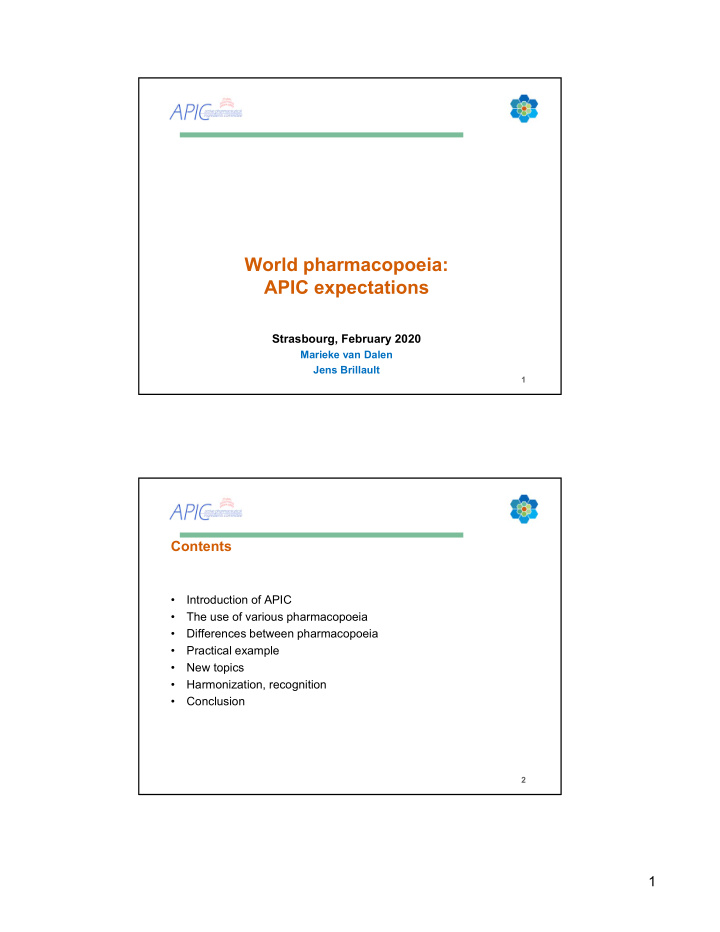



World pharmacopoeia: APIC expectations Strasbourg, February 2020 Marieke van Dalen Jens Brillault 1 Contents • Introduction of APIC • The use of various pharmacopoeia • Differences between pharmacopoeia • Practical example • New topics • Harmonization, recognition • Conclusion 2 1
Introduction of APIC What / who is APIC? • A Technical European Industry Association, based in Brussels • Focused on APIs from a quality and regulatory perspective APIC‘s Mission • To promote the use of compliant APIs in medicinal products to ensure patient safety • To represent the interests of pharmaceutical and chemical companies producing APIs and intermediates in Europe by being recognized experts who advance and influence the global GMP and Regulatory environment 3 The use of various pharmacopoeia • For dedicated API producers, the way to release the API is dependent on the number and the location of their customers. • Most of the API producers are selling their APIs on a global scale, meaning they have to release their API for use all over the world and thus in compliance with many different pharmacopoeia. • Also, the API may be used in a variety of drug products and dosage forms which may complicate the release further (think about additional specifications in case of injectables vs. oral dosage forms). 4 2
The use of various pharmacopoeia • There is no way to get around all these different pharmacopoeial requirements, as in many regions the “local” pharmacopoeia is requested as the standard. • This means that often analyses are more or less repeated (but slightly different) without bringing additional safety to the API and/or the drug product 5 Differences between pharmacopoeia • Unfortunately, there are many differences between the various pharmacopoeia. • Many of these stem from history. • There are and have been several programmes to try and harmonize these differences, but it is a tough job. • As an example: while harmonization was sometimes achieved in the english language, subsequent translations into national pharmacopoeia led to difference in the final texts. 6 3
Practical example 7 Practical example • So, let us look at the assay, one of the most important parameters for any API: EP: UV absorption test, calculated on anhydrous substance USP: HPLC, calculated on anhydrous substance JPC: UV absorption test, calculated on dried substance. • The loss on drying in most cases is not the same as the water content. Yet, both are used for the calculation of the assay. UV may be regarded as an outdated method, as there are more state of the art HPLC methods available… • So, again, three analyses without additional value. 8 4
Practical example • The use of the different methods and calculations does not contribute to the quality and/or the safety of the API. • For Industry it is hard to see why so much differences are there and why it is apparently so difficult to harmonize. • Regulatory agencies all around the world often require compliance with the local pharmacopoeia, without recognition of other pharmacopoeia. 9 New topics • One would think that new topics could also be a starting point for harmonization: examples are the introduction of ICH guidelines and incidents in the world. • However, the implementation of e.g. Q3D has proven to be different in the various regions, specifically when it comes to timelines. The early USP approach (if the risk assessment had been performed and -where applicable- the resulting tests had been implemented, there was no longer a need to perform the heavy metals test) was very much appreciated by Industry as this showed a science based approach. 10 5
New topics • The current nitrosamines case is another example where Industry would expect the various pharmacopoeia to work together and to come up with similar specifications and analytical methods. The patients’ safety needs to be ensured, regardless of where they live. • This is yet another opportunity where everybody starts “from scratch”. 11 Harmonization, recognition • Harmonization is only possible if all parties have the same intention. • We understand that there may be difficulties, e.g. we understand WHO pleading for analyses that can be performed in all countries, also those without state of the art equipment. • An additional problem may be the language: as long as official texts are not published in english, it is difficult to estimate whether a harmonized english text will still be harmonized after translation. 12 6
Harmonization, recognition • There have been some successes in the past, e.g. under the ICH umbrella where a number of tests have been harmonized under Q4B. • Unfortunately, not so many API tests. • The work in this Pharmacopoeial Discussion Group (PDG) seems to have ended, even though there is so much more work to be done. 13 Harmonization, recognition • Recognition is probably more in the hands of the regulatory bodies who request full compliance with the local pharmacopoeia. • This sometimes leads to problems, e.g. when a test in the Japanese monograph describes the use of chloroform, which is prohibited in most West European laboratories, or where odor tests are still described. Also in some regions without a pharmacopoeial monograph, full validation studies for a pharmacopoeial method are required, which is usually not the case. 14 7
Conclusion • APIC strongly encourages the world pharmacopoeia to work together and to harmonize whenever possible. • The current situation, with many small and big differences in the tests leads to unnecessary redundant testing which comes at a price. 15 16 8
Recommend
More recommend